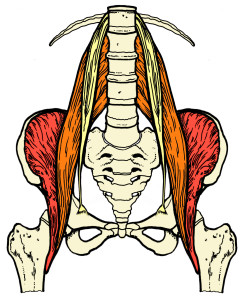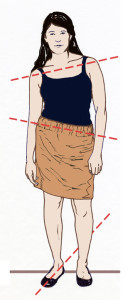 Pain that manifests as a result of psoas major muscle dysfunction can take all forms.
Pain that manifests as a result of psoas major muscle dysfunction can take all forms.
In today’s post we will look at lower back pain.
The lower back or lumbar spine are five bones that make up the portion of the spinal column between the pelvis and the rib cage.
The lumbar spine provides the only skeletal support between the pelvis and the ribcage.
These five bones, the largest five bones of the spine, living directly in the center of the body, require a great deal of muscle tone to live in the proper alignment.
The small inward curve of the lumbar spine is incredibly important if we want to have successful upright posture and good movement patterns.
Unfortunately, a tight psoas muscle tends to pull the lumbar spine into too much of a curve which has all sorts of implications for back pain.
The function of the psoas is to pull the bones of the lumbar spine forward and down when it engages or shortens.
If it engages or shortens too often, or actually stays shortened, it can compress the bones at the back of the lower spine as well as force the muscles (quadratus lumborum, spinal erectors) in the same area into a chronically shortened position.
Don’t forget that we have two psoas, and while both can and often do become tight, having one psoas that is a lot tighter than the other, wreaks its own particular havoc upon the lower back.
When one psoas is tighter than the other a pattern tends to develop.
While there are themes and variations, the pull of a tight psoas usually presents as one foot (the tighter side) turned out more than the other.
The hip on the same side as the turned-out foot tends to be higher than its opposite, and in a counterintuitive stroke the same shoulder is pulled down towards the raised hip.
You would think if one hip is higher, that same shoulder would be higher as well.
But when the psoas is tight on one side it basically crunches that side of the body. The foot turns out because the leg bone that the tight psoas attached to on the back of the inner thigh, is pulled up into the hip socket which draws both the inner thigh and foot into external rotation.
This is the result of just one tight psoas pattern (there are many) but it is easy to see by looking at the picture how the shortened side between the pelvis and the ribcage creates a compression of the lumbar bones that could cause pain and lead to herniated discs.
The hiked-up pelvis can have a profound effect on the sacroiliac joint (SI), which is also the cause or source of a great deal of back pain.
The tight psoas impinges on the SI joint limiting its space and its ability to move.
The psoas has a partner at the back of the body called the piriformis muscle and a tight psoas always affects the piriformis.
And it just so happens that the sciatic nerve forms directly behind the piriformis muscle. And wouldn’t you know that a tight psoas can also tight one or both of the piriformis which can press on the sciatic nerve, etc., etc?
I’ll leave you with that and go into how a dysfunctional psoas major muscle can affect the shoulder, knee, ankle, and foot (you can see it in the picture) in other posts about the amazing psoas muscle.
